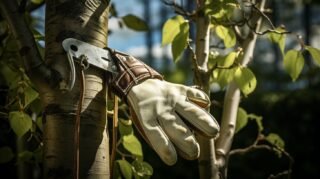Table of Contents
Few sights are as disheartening as a dead oak tree. This majestic species of tree can live for centuries, but sometimes they succumb to disease, pests, or simply old age. But fear not! There are ways to revive your dying oak tree and bring it back to life. With the right care and attention, you can enjoy the beauty of your oak tree for many more years to come.
Key Takeaways:
- Assess the situation and consult with a tree expert before taking action.
- Trim dead branches and remove diseased limbs.
- Inject fungicide and fertilize the tree to promote its health.
- Mulch and water the tree regularly to provide necessary nutrients and hydration.
- Seek professional help when dealing with complex tree diseases or the need for tree removal.
- Accept the loss and replant a new oak tree if it is too late to save the dying tree.
Signs of a Dying Oak Tree
If your oak tree is in danger of dying or has dropped leaves, you should act quickly. The following are the most effective ways to save an oak tree that is dying.
1. Yellow Leaves: One of the first signs of a dying oak tree is yellowing leaves. If you notice that all or most of the leaves have turned yellow with greenish veins, it could be a sign of malnutrition. Conduct a soil test to ensure your oak tree is getting the proper nutrients it needs.
2. Foliage Loss: Excessive leaf drop that is unrelated to the normal change in season is another sign of a dying oak tree. This could be caused by insect damage, fungal infection, water stress, or nutrient deficiency. If left untreated, these problems can lead to the eventual death of the tree.
3. Dead Branches: Inspect the branches of your oak tree. If new growth appears only on the lower branches, with brown leaves appearing on the upper ones, it is a sign that the tree is likely dying. Trim and remove any dead branches to prevent the spread of disease.
4. Powdery Mildew: Powdery mildew is a fungal disease characterized by the presence of white, powder-like mildew on the leaves. It can cause new foliage to die and fall off, weakening the canopy of the tree. Treat with an appropriate fungicide to prevent further spread.
5. Bark Decay: Healthy oak trees have green tissue under the bark. If you notice decaying bark that is falling off or brown or yellow tissue underneath, it is an indication that the tree is dying or dead. Fungal growth at the base of the tree can also be a sign of severe root decay.
Acting quickly and addressing these signs of a dying oak tree can help save your tree from further decline. Pruning, removing dead branches, applying fungicides, and ensuring proper drainage and nutrition are key steps to revive a dying oak tree. However, it is important to consult with a certified arborist or tree care specialist for an accurate diagnosis and tailored treatment plan. Remember, timely action can make all the difference in saving your oak tree.
Treating a Dying Oak Tree
Oak trees that have been diagnosed as dying or diseased can be saved by following a few essential steps. By trimming dead branches and discarding the affected limbs, you can remove the source of the disease and prevent its spread. It is important to use sharp pruning tools and make clean cuts to minimize damage to the tree.
Once the dead branches have been removed, it is crucial to spray or inject the tree with a fungicide. This will help control any fungal infections that may be causing or contributing to the tree’s decline. Be sure to follow the manufacturer’s instructions for proper application of the fungicide.
In addition to fungicide treatment, providing proper care for the tree is essential for its recovery. Fertilization is important to provide essential nutrients and support the tree’s overall health. Mulching around the base of the tree helps retain moisture, regulate soil temperature, and suppress weed growth. Regular watering is also crucial, especially during dry periods, to ensure the tree receives adequate hydration.
Additional Tips for Treating a Dying Oak Tree:
- Regularly monitor the tree for any signs of new disease or decay.
- Consult with a tree specialist or arborist for professional advice and guidance.
- Follow a proper maintenance schedule, including regular pruning and inspection.
- Consider implementing a comprehensive tree care plan to ensure the long-term health of the oak tree.
By following these steps and providing proper care, you can increase the chances of saving a dying oak tree and restoring it to its full health and beauty.
Conclusion
Treating a dying oak tree requires prompt action and proper care. By trimming dead branches, applying fungicide, and providing essential nutrients, mulch, and water, you can give your oak tree the best chance of recovery. It is crucial to consult with a tree specialist or arborist for expert advice and guidance throughout the process. With proper treatment and ongoing tree care, you can revive your dying oak tree and ensure its longevity for years to come.
When to Seek Professional Help
While many steps can be taken to save a dying oak tree, there are instances where professional help is necessary to ensure the tree’s survival. A tree specialist or oak tree specialist has the expertise and knowledge to diagnose the underlying issues and provide the appropriate treatment. Here are a few situations where seeking professional help is essential:
- Complex tree diseases: If your oak tree is affected by a severe or complicated tree disease such as oak wilt or sudden oak death, it is crucial to consult a tree specialist. These professionals have the expertise to identify the disease and recommend the most effective treatment options.
- Tree removal: Sometimes, despite your best efforts, a dying oak tree cannot be saved. In such cases, a professional tree removal service should be called in. They have the necessary equipment and training to safely and efficiently remove the dead tree without causing damage to the surrounding area.
- Expert advice: If you are unsure about the best course of action for your dying oak tree, consulting a tree specialist is always a wise decision. They can assess the tree’s condition, identify any potential hazards, and provide professional advice on the best treatment options or whether tree removal is necessary.
Remember, attempting to treat or remove a dying oak tree without the necessary expertise can be dangerous and may further harm the tree or put yourself at risk. It is always better to rely on the knowledge and experience of professionals when dealing with a dying oak tree.
When to Accept the Loss
Despite our best efforts, there are circumstances when a dying oak tree is beyond saving and must be removed. It can be heartbreaking to accept the loss of a majestic tree that has stood for years, providing shade and beauty to your landscape. However, it is important to recognize when the tree is no longer viable and poses a risk to your property or surrounding trees.
When a dying oak tree shows severe decay, with large portions of the trunk or branches rotting away, it is a clear indication that the tree is beyond saving. Dead branches that easily break off and a dry, brittle bark are signs of advanced decay. In such cases, it is best to consult with a professional tree specialist who can assess the tree’s condition and recommend the appropriate course of action.
If the tree has been diagnosed with a highly contagious and destructive disease like oak wilt or sudden oak death, it may be necessary to remove the tree to prevent further spread to other trees in the area. These diseases can rapidly kill oak trees and have no cure, making tree removal the only option to protect the surrounding ecosystem.
When determining whether to accept the loss of a dying oak tree, it is essential to consider the safety aspect. If the tree has become unstable, with large branches hanging precariously or the entire tree leaning dangerously, it poses a significant risk to people and property. In such cases, it is crucial to seek professional help immediately to remove the tree safely.
FAQ
Q: Can a dying oak tree be saved?
A: If the disease is detected early, it may be possible to restore the tree’s health. Removing deadwood and diseased branches, as well as applying fungicides, can help save a dying oak tree.
Q: What are the signs of a dying oak tree?
A: Signs of a dying oak tree include yellow leaves, foliage loss, dead branches, decaying bark, and fungus growth. These symptoms indicate that the tree is in distress and may be dying.
Q: How can I treat a dying oak tree?
A: To treat a dying oak tree, it is important to trim dead branches, remove diseased limbs, and apply fungicides. Fertilizing, mulching, and watering the tree can also help promote its recovery.
Q: When should I seek professional help for a dying oak tree?
A: It is advisable to seek professional help from a tree specialist when dealing with a dying oak tree. They can provide expertise in diagnosing tree diseases and determining the best course of action, including tree removal if necessary.
Q: When is it too late to save a dying oak tree?
A: If the tree has decaying bark, fungus growth at the base, or insect infestations, it may be too late to save the tree. In such cases, it is recommended to remove the tree to prevent further damage.
Q: Can a dead oak tree be revived?
A: A dead oak tree cannot be revived. If the tree is truly dead, it is best to remove it and replant a new oak tree in its place to ensure the health and safety of the surrounding area.







